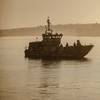EMS Satcom, a division of EMS Technologies, Inc., announced its sponsorship of Spirit of Canada Ocean Challenges and skipper Derek Hatfield as he sets his sights to win the 2006 5-Oceans global sailboat race. EMS will provide critical hardware and services through its integrated satellite communications systems to connect Derek and his 60-ft. Spirit of Canada to the rest of the world for safety, educational and media relations purposes.
“Spirit of Canada is building to win in 2006, and the addition of EMS’s world-class Satcom technology provides us with tremendous advantages in terms of safety and educational outreach,” says Derek Hatfield, managing director, Spirit of Canada Ocean Challenges. “But it’s our supporters and sponsors who benefit most as our video and e-mail capabilities will transform the race into a unique and scintillating spectator sport accessible to millions of people via the Internet and television.”
Construction of the new Open 60 ocean racer, Spirit of Canada, begins in September, and the boat promises to be one of the most technologically advanced racing machines in the world. EMS SATCOM engineers will work alongside the builders to “wire” the boat with capabilities that will include: satellite voice communications, weather tracking and reporting, e-mail and fax capabilities, as well as video transfer functions similar to those embedded journalists used to cover the war in Iraq.
Using the satellite link, Derek can conduct television interviews from the boat, support a daily Internet blog, and exchange e-mails with kids as part of Spirit of Canada’s global education program that teaches children about the ocean and the environment. As well, an array of video cameras attached to various vantage points will provide daily webcam feeds featuring raw footage from the deck of Spirit of Canada.
EMS SATCOM will provide the latest in marine communications with its key component being the Inmarsat Fleet 55 high-speed data terminal. “We are extremely pleased to be able to supply Derek with the most advanced maritime technology, and we trust its availability will both help him stay tactically ahead of his competition, and enable the world at large to monitor his progress,” commented Jay McMillan, director, Land Mobile and Maritime Division of EMS SATCOM.
In addition to its two-way high-speed satellite communications products, EMS has provided ground equipment and management systems for use with the COSPAS-SARSAT satellite system since its launch in 1981. The COSPAS-SARSAT system has been credited with saving more than 15,000 lives by using spacecraft and ground facilities to detect and locate signals from distress beacons.
“The rigorous demands of racing around the world alone means staying in touch with the race team is critical,” says Hatfield. “With EMS technology aboard, having been tested time and again in the most rugged and demanding search-and-rescue situations, I’ll have a tremendous sense of assurance, allowing me to focus on the race.”
Featured videos

Inside the Electrified Truckable Tug

Tracking Foreign Vessels Working in the U.S. Jones Act Market

Inmarsat Enhances Service to Drive Digitalization
Subscribe for
Maritime Reporter E-News
Maritime Reporter E-News is the maritime industry's largest circulation and most authoritative ENews Service, delivered to your Email five times per week









